Diabetes as a National Health Priority in Singapore
VerifiedAdded on 2023/04/24
|10
|2671
|419
AI Summary
This assignment discusses the prevalence, complications, and health promotion strategies for diabetes in Singapore. It emphasizes the need for a comprehensive approach using the ecological model to cover family, community, and society as well as individuals.
Contribute Materials
Your contribution can guide someone’s learning journey. Share your
documents today.
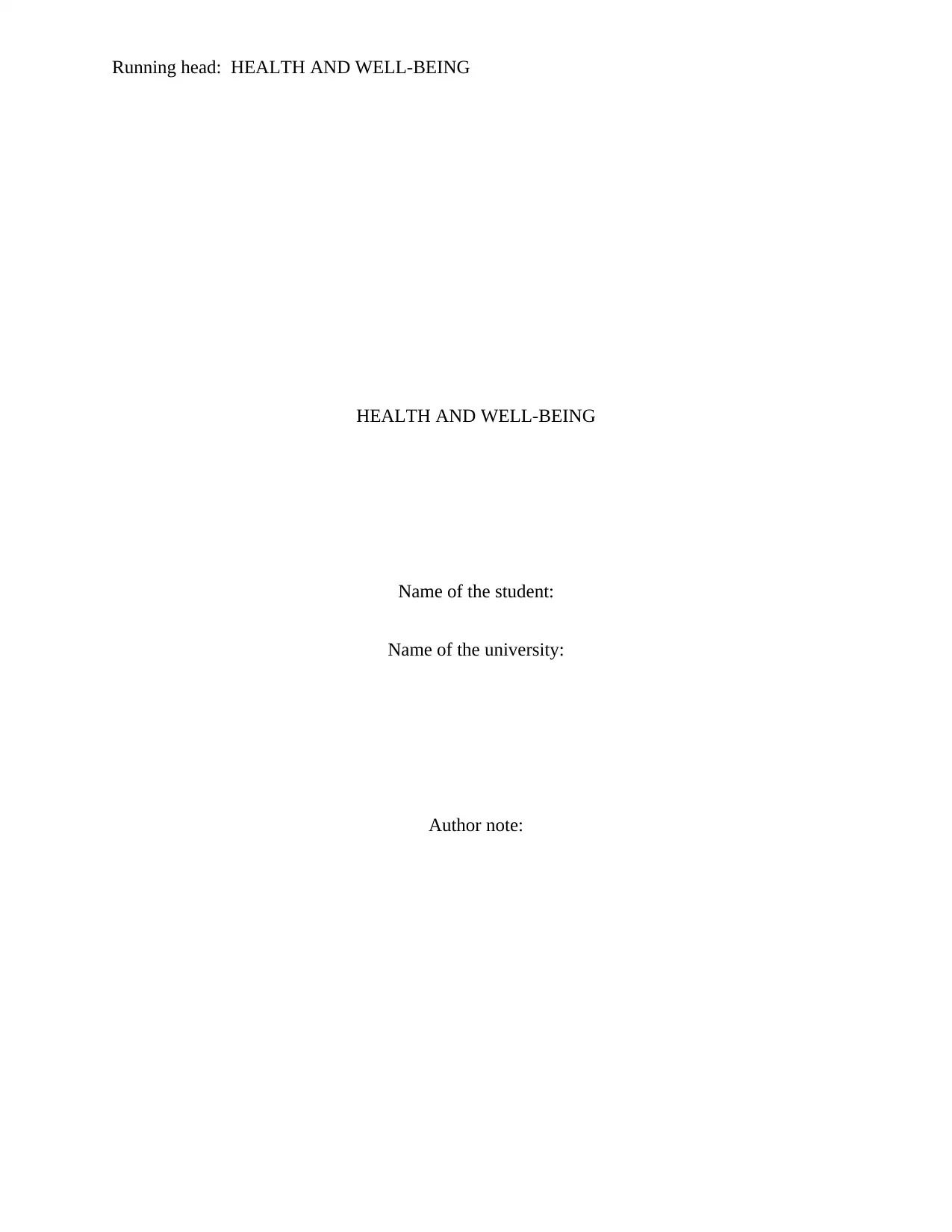
Running head: HEALTH AND WELL-BEING
HEALTH AND WELL-BEING
Name of the student:
Name of the university:
Author note:
HEALTH AND WELL-BEING
Name of the student:
Name of the university:
Author note:
Secure Best Marks with AI Grader
Need help grading? Try our AI Grader for instant feedback on your assignments.
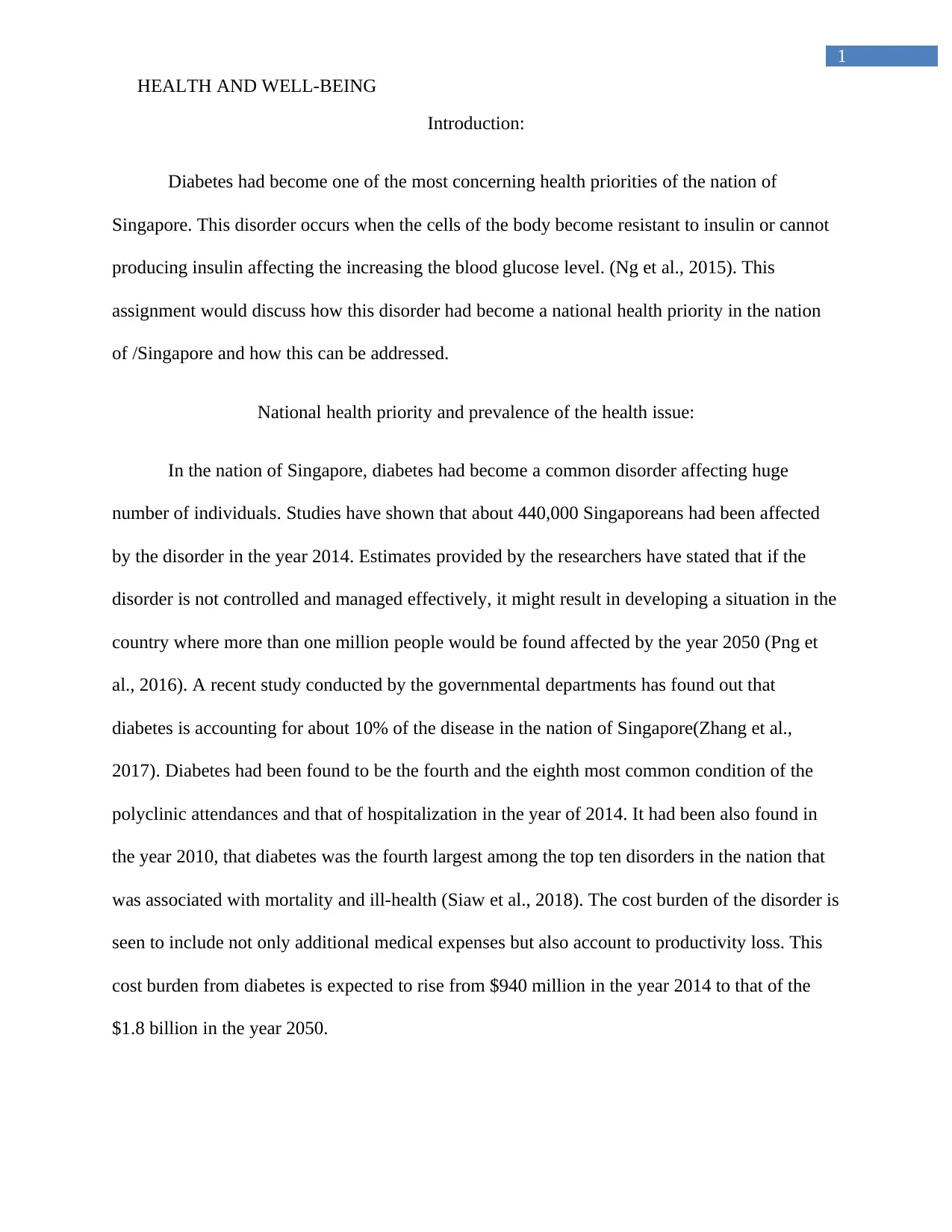
1
HEALTH AND WELL-BEING
Introduction:
Diabetes had become one of the most concerning health priorities of the nation of
Singapore. This disorder occurs when the cells of the body become resistant to insulin or cannot
producing insulin affecting the increasing the blood glucose level. (Ng et al., 2015). This
assignment would discuss how this disorder had become a national health priority in the nation
of /Singapore and how this can be addressed.
National health priority and prevalence of the health issue:
In the nation of Singapore, diabetes had become a common disorder affecting huge
number of individuals. Studies have shown that about 440,000 Singaporeans had been affected
by the disorder in the year 2014. Estimates provided by the researchers have stated that if the
disorder is not controlled and managed effectively, it might result in developing a situation in the
country where more than one million people would be found affected by the year 2050 (Png et
al., 2016). A recent study conducted by the governmental departments has found out that
diabetes is accounting for about 10% of the disease in the nation of Singapore(Zhang et al.,
2017). Diabetes had been found to be the fourth and the eighth most common condition of the
polyclinic attendances and that of hospitalization in the year of 2014. It had been also found in
the year 2010, that diabetes was the fourth largest among the top ten disorders in the nation that
was associated with mortality and ill-health (Siaw et al., 2018). The cost burden of the disorder is
seen to include not only additional medical expenses but also account to productivity loss. This
cost burden from diabetes is expected to rise from $940 million in the year 2014 to that of the
$1.8 billion in the year 2050.
HEALTH AND WELL-BEING
Introduction:
Diabetes had become one of the most concerning health priorities of the nation of
Singapore. This disorder occurs when the cells of the body become resistant to insulin or cannot
producing insulin affecting the increasing the blood glucose level. (Ng et al., 2015). This
assignment would discuss how this disorder had become a national health priority in the nation
of /Singapore and how this can be addressed.
National health priority and prevalence of the health issue:
In the nation of Singapore, diabetes had become a common disorder affecting huge
number of individuals. Studies have shown that about 440,000 Singaporeans had been affected
by the disorder in the year 2014. Estimates provided by the researchers have stated that if the
disorder is not controlled and managed effectively, it might result in developing a situation in the
country where more than one million people would be found affected by the year 2050 (Png et
al., 2016). A recent study conducted by the governmental departments has found out that
diabetes is accounting for about 10% of the disease in the nation of Singapore(Zhang et al.,
2017). Diabetes had been found to be the fourth and the eighth most common condition of the
polyclinic attendances and that of hospitalization in the year of 2014. It had been also found in
the year 2010, that diabetes was the fourth largest among the top ten disorders in the nation that
was associated with mortality and ill-health (Siaw et al., 2018). The cost burden of the disorder is
seen to include not only additional medical expenses but also account to productivity loss. This
cost burden from diabetes is expected to rise from $940 million in the year 2014 to that of the
$1.8 billion in the year 2050.
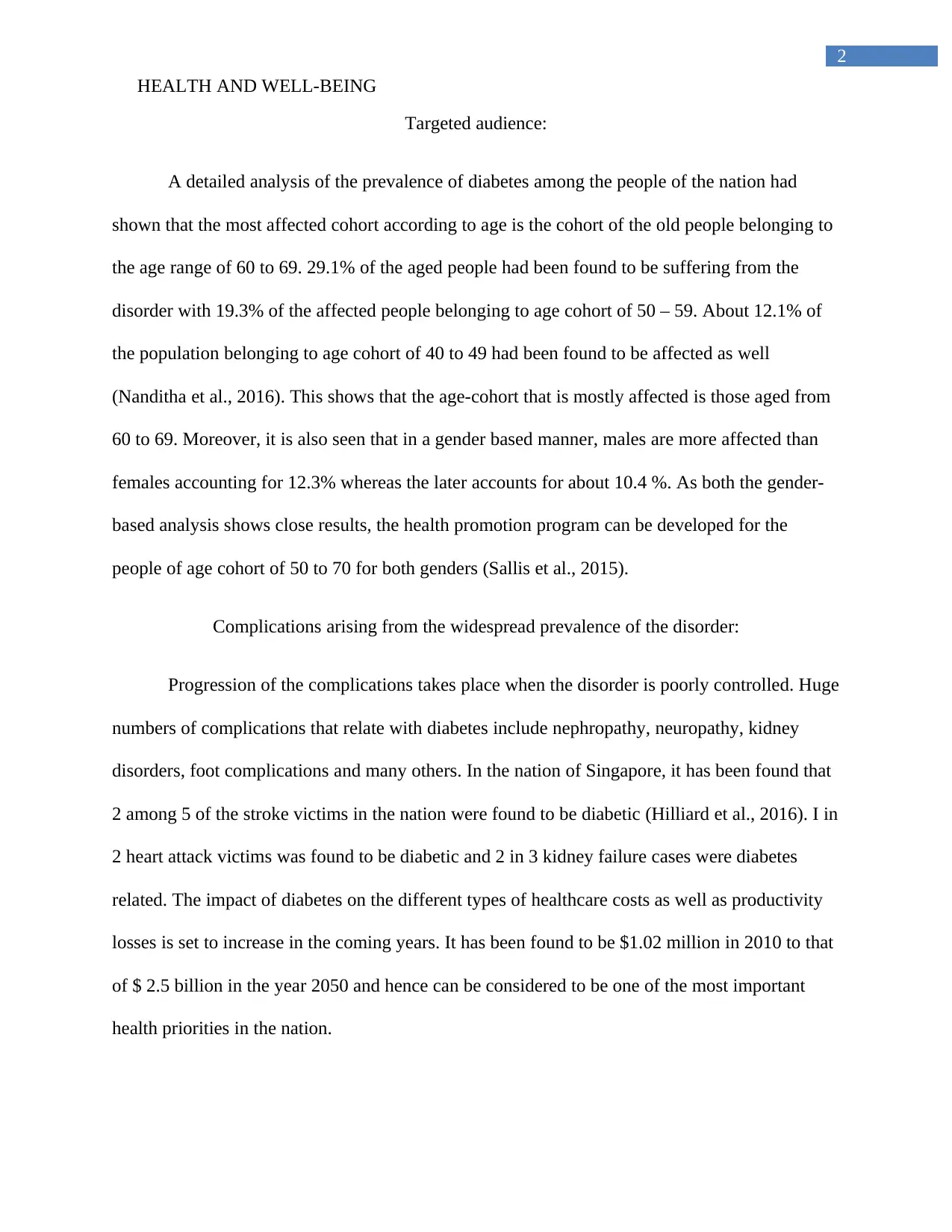
2
HEALTH AND WELL-BEING
Targeted audience:
A detailed analysis of the prevalence of diabetes among the people of the nation had
shown that the most affected cohort according to age is the cohort of the old people belonging to
the age range of 60 to 69. 29.1% of the aged people had been found to be suffering from the
disorder with 19.3% of the affected people belonging to age cohort of 50 – 59. About 12.1% of
the population belonging to age cohort of 40 to 49 had been found to be affected as well
(Nanditha et al., 2016). This shows that the age-cohort that is mostly affected is those aged from
60 to 69. Moreover, it is also seen that in a gender based manner, males are more affected than
females accounting for 12.3% whereas the later accounts for about 10.4 %. As both the gender-
based analysis shows close results, the health promotion program can be developed for the
people of age cohort of 50 to 70 for both genders (Sallis et al., 2015).
Complications arising from the widespread prevalence of the disorder:
Progression of the complications takes place when the disorder is poorly controlled. Huge
numbers of complications that relate with diabetes include nephropathy, neuropathy, kidney
disorders, foot complications and many others. In the nation of Singapore, it has been found that
2 among 5 of the stroke victims in the nation were found to be diabetic (Hilliard et al., 2016). I in
2 heart attack victims was found to be diabetic and 2 in 3 kidney failure cases were diabetes
related. The impact of diabetes on the different types of healthcare costs as well as productivity
losses is set to increase in the coming years. It has been found to be $1.02 million in 2010 to that
of $ 2.5 billion in the year 2050 and hence can be considered to be one of the most important
health priorities in the nation.
HEALTH AND WELL-BEING
Targeted audience:
A detailed analysis of the prevalence of diabetes among the people of the nation had
shown that the most affected cohort according to age is the cohort of the old people belonging to
the age range of 60 to 69. 29.1% of the aged people had been found to be suffering from the
disorder with 19.3% of the affected people belonging to age cohort of 50 – 59. About 12.1% of
the population belonging to age cohort of 40 to 49 had been found to be affected as well
(Nanditha et al., 2016). This shows that the age-cohort that is mostly affected is those aged from
60 to 69. Moreover, it is also seen that in a gender based manner, males are more affected than
females accounting for 12.3% whereas the later accounts for about 10.4 %. As both the gender-
based analysis shows close results, the health promotion program can be developed for the
people of age cohort of 50 to 70 for both genders (Sallis et al., 2015).
Complications arising from the widespread prevalence of the disorder:
Progression of the complications takes place when the disorder is poorly controlled. Huge
numbers of complications that relate with diabetes include nephropathy, neuropathy, kidney
disorders, foot complications and many others. In the nation of Singapore, it has been found that
2 among 5 of the stroke victims in the nation were found to be diabetic (Hilliard et al., 2016). I in
2 heart attack victims was found to be diabetic and 2 in 3 kidney failure cases were diabetes
related. The impact of diabetes on the different types of healthcare costs as well as productivity
losses is set to increase in the coming years. It has been found to be $1.02 million in 2010 to that
of $ 2.5 billion in the year 2050 and hence can be considered to be one of the most important
health priorities in the nation.
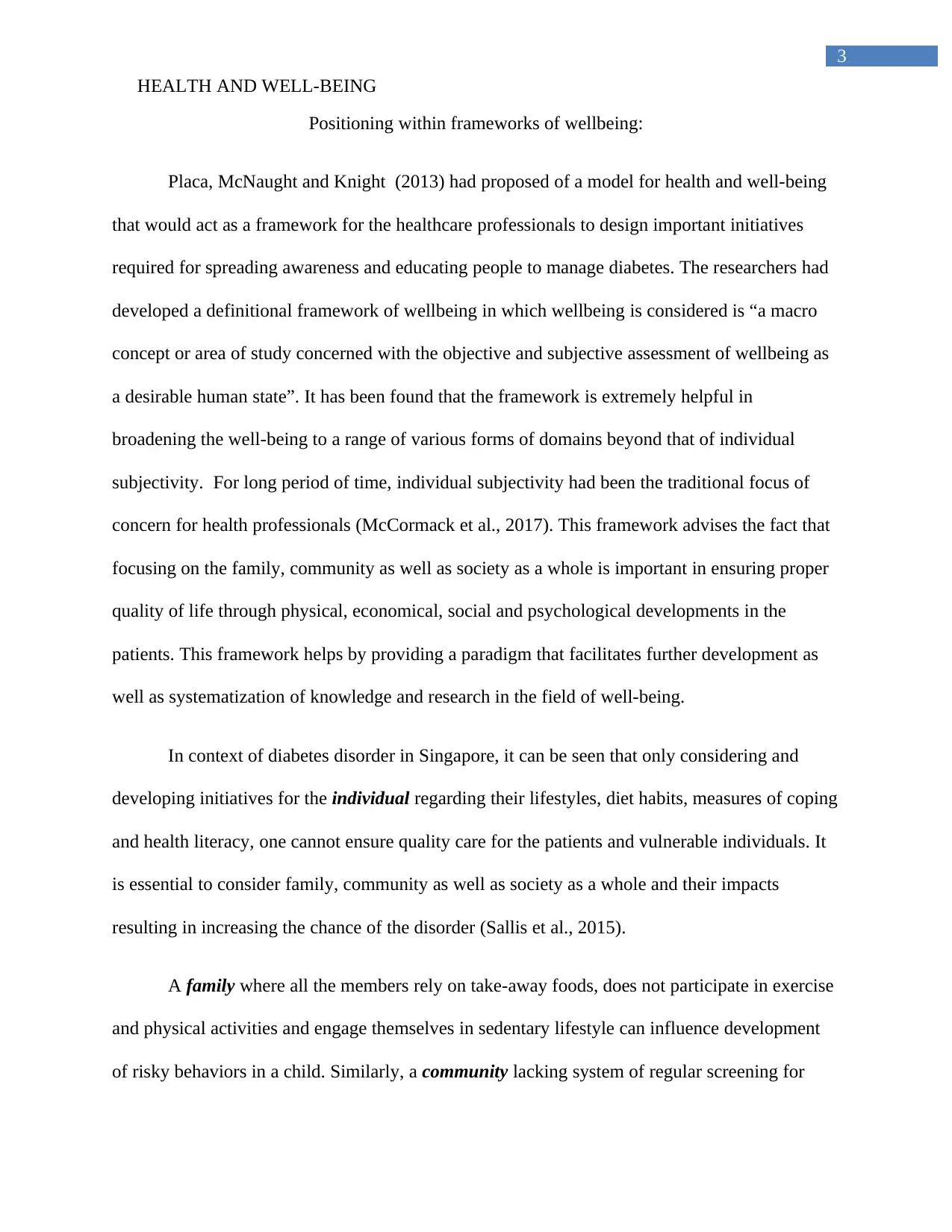
3
HEALTH AND WELL-BEING
Positioning within frameworks of wellbeing:
Placa, McNaught and Knight (2013) had proposed of a model for health and well-being
that would act as a framework for the healthcare professionals to design important initiatives
required for spreading awareness and educating people to manage diabetes. The researchers had
developed a definitional framework of wellbeing in which wellbeing is considered is “a macro
concept or area of study concerned with the objective and subjective assessment of wellbeing as
a desirable human state”. It has been found that the framework is extremely helpful in
broadening the well-being to a range of various forms of domains beyond that of individual
subjectivity. For long period of time, individual subjectivity had been the traditional focus of
concern for health professionals (McCormack et al., 2017). This framework advises the fact that
focusing on the family, community as well as society as a whole is important in ensuring proper
quality of life through physical, economical, social and psychological developments in the
patients. This framework helps by providing a paradigm that facilitates further development as
well as systematization of knowledge and research in the field of well-being.
In context of diabetes disorder in Singapore, it can be seen that only considering and
developing initiatives for the individual regarding their lifestyles, diet habits, measures of coping
and health literacy, one cannot ensure quality care for the patients and vulnerable individuals. It
is essential to consider family, community as well as society as a whole and their impacts
resulting in increasing the chance of the disorder (Sallis et al., 2015).
A family where all the members rely on take-away foods, does not participate in exercise
and physical activities and engage themselves in sedentary lifestyle can influence development
of risky behaviors in a child. Similarly, a community lacking system of regular screening for
HEALTH AND WELL-BEING
Positioning within frameworks of wellbeing:
Placa, McNaught and Knight (2013) had proposed of a model for health and well-being
that would act as a framework for the healthcare professionals to design important initiatives
required for spreading awareness and educating people to manage diabetes. The researchers had
developed a definitional framework of wellbeing in which wellbeing is considered is “a macro
concept or area of study concerned with the objective and subjective assessment of wellbeing as
a desirable human state”. It has been found that the framework is extremely helpful in
broadening the well-being to a range of various forms of domains beyond that of individual
subjectivity. For long period of time, individual subjectivity had been the traditional focus of
concern for health professionals (McCormack et al., 2017). This framework advises the fact that
focusing on the family, community as well as society as a whole is important in ensuring proper
quality of life through physical, economical, social and psychological developments in the
patients. This framework helps by providing a paradigm that facilitates further development as
well as systematization of knowledge and research in the field of well-being.
In context of diabetes disorder in Singapore, it can be seen that only considering and
developing initiatives for the individual regarding their lifestyles, diet habits, measures of coping
and health literacy, one cannot ensure quality care for the patients and vulnerable individuals. It
is essential to consider family, community as well as society as a whole and their impacts
resulting in increasing the chance of the disorder (Sallis et al., 2015).
A family where all the members rely on take-away foods, does not participate in exercise
and physical activities and engage themselves in sedentary lifestyle can influence development
of risky behaviors in a child. Similarly, a community lacking system of regular screening for
Secure Best Marks with AI Grader
Need help grading? Try our AI Grader for instant feedback on your assignments.
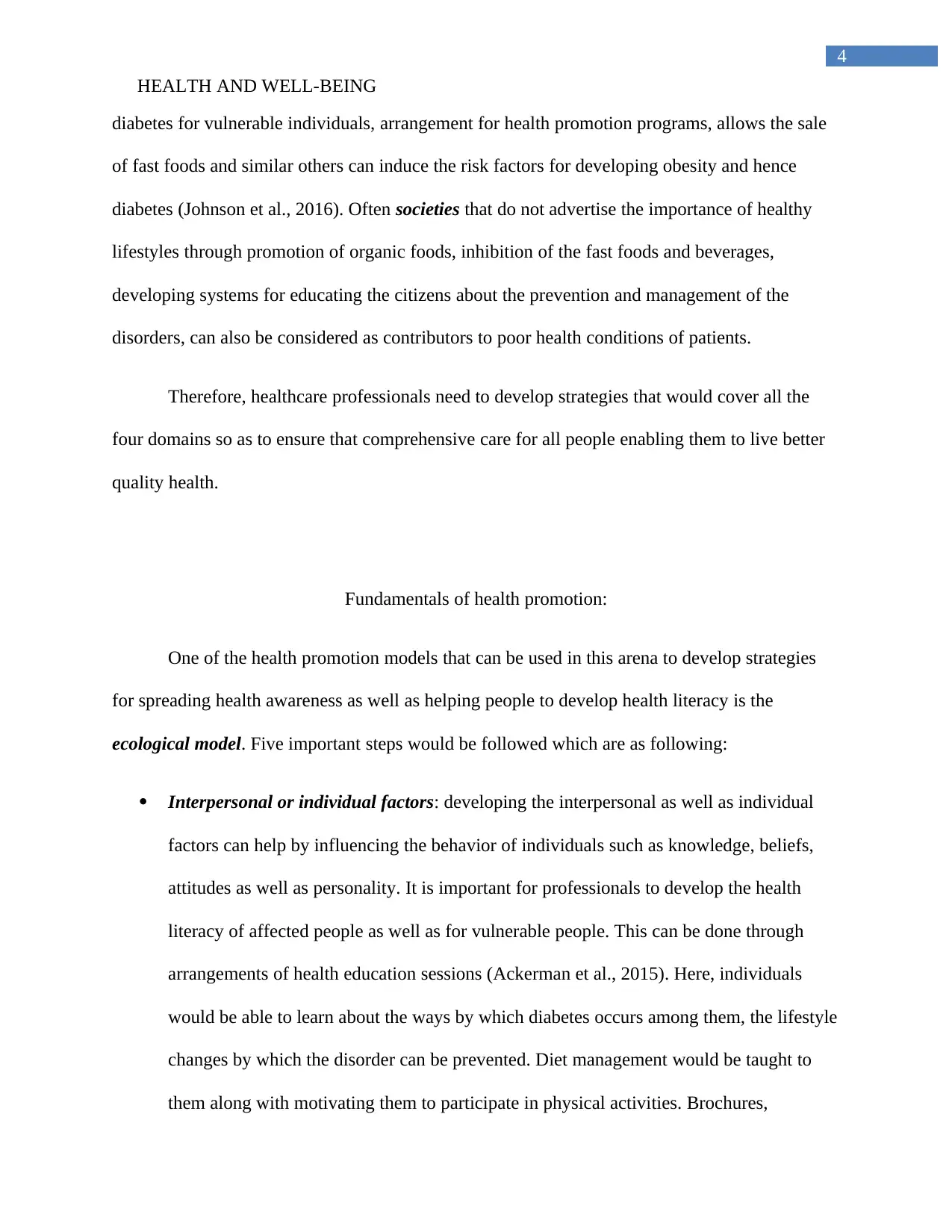
4
HEALTH AND WELL-BEING
diabetes for vulnerable individuals, arrangement for health promotion programs, allows the sale
of fast foods and similar others can induce the risk factors for developing obesity and hence
diabetes (Johnson et al., 2016). Often societies that do not advertise the importance of healthy
lifestyles through promotion of organic foods, inhibition of the fast foods and beverages,
developing systems for educating the citizens about the prevention and management of the
disorders, can also be considered as contributors to poor health conditions of patients.
Therefore, healthcare professionals need to develop strategies that would cover all the
four domains so as to ensure that comprehensive care for all people enabling them to live better
quality health.
Fundamentals of health promotion:
One of the health promotion models that can be used in this arena to develop strategies
for spreading health awareness as well as helping people to develop health literacy is the
ecological model. Five important steps would be followed which are as following:
Interpersonal or individual factors: developing the interpersonal as well as individual
factors can help by influencing the behavior of individuals such as knowledge, beliefs,
attitudes as well as personality. It is important for professionals to develop the health
literacy of affected people as well as for vulnerable people. This can be done through
arrangements of health education sessions (Ackerman et al., 2015). Here, individuals
would be able to learn about the ways by which diabetes occurs among them, the lifestyle
changes by which the disorder can be prevented. Diet management would be taught to
them along with motivating them to participate in physical activities. Brochures,
HEALTH AND WELL-BEING
diabetes for vulnerable individuals, arrangement for health promotion programs, allows the sale
of fast foods and similar others can induce the risk factors for developing obesity and hence
diabetes (Johnson et al., 2016). Often societies that do not advertise the importance of healthy
lifestyles through promotion of organic foods, inhibition of the fast foods and beverages,
developing systems for educating the citizens about the prevention and management of the
disorders, can also be considered as contributors to poor health conditions of patients.
Therefore, healthcare professionals need to develop strategies that would cover all the
four domains so as to ensure that comprehensive care for all people enabling them to live better
quality health.
Fundamentals of health promotion:
One of the health promotion models that can be used in this arena to develop strategies
for spreading health awareness as well as helping people to develop health literacy is the
ecological model. Five important steps would be followed which are as following:
Interpersonal or individual factors: developing the interpersonal as well as individual
factors can help by influencing the behavior of individuals such as knowledge, beliefs,
attitudes as well as personality. It is important for professionals to develop the health
literacy of affected people as well as for vulnerable people. This can be done through
arrangements of health education sessions (Ackerman et al., 2015). Here, individuals
would be able to learn about the ways by which diabetes occurs among them, the lifestyle
changes by which the disorder can be prevented. Diet management would be taught to
them along with motivating them to participate in physical activities. Brochures,
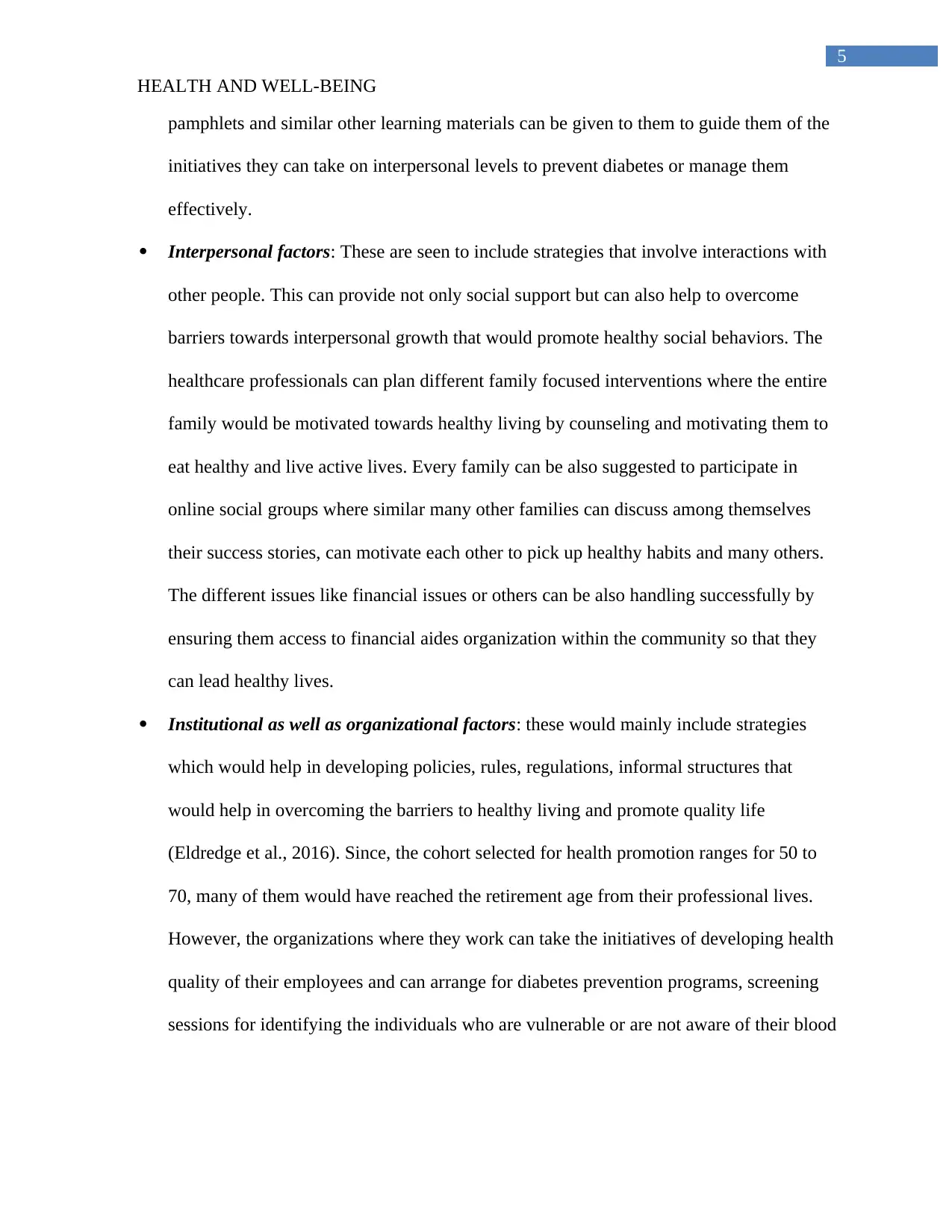
5
HEALTH AND WELL-BEING
pamphlets and similar other learning materials can be given to them to guide them of the
initiatives they can take on interpersonal levels to prevent diabetes or manage them
effectively.
Interpersonal factors: These are seen to include strategies that involve interactions with
other people. This can provide not only social support but can also help to overcome
barriers towards interpersonal growth that would promote healthy social behaviors. The
healthcare professionals can plan different family focused interventions where the entire
family would be motivated towards healthy living by counseling and motivating them to
eat healthy and live active lives. Every family can be also suggested to participate in
online social groups where similar many other families can discuss among themselves
their success stories, can motivate each other to pick up healthy habits and many others.
The different issues like financial issues or others can be also handling successfully by
ensuring them access to financial aides organization within the community so that they
can lead healthy lives.
Institutional as well as organizational factors: these would mainly include strategies
which would help in developing policies, rules, regulations, informal structures that
would help in overcoming the barriers to healthy living and promote quality life
(Eldredge et al., 2016). Since, the cohort selected for health promotion ranges for 50 to
70, many of them would have reached the retirement age from their professional lives.
However, the organizations where they work can take the initiatives of developing health
quality of their employees and can arrange for diabetes prevention programs, screening
sessions for identifying the individuals who are vulnerable or are not aware of their blood
HEALTH AND WELL-BEING
pamphlets and similar other learning materials can be given to them to guide them of the
initiatives they can take on interpersonal levels to prevent diabetes or manage them
effectively.
Interpersonal factors: These are seen to include strategies that involve interactions with
other people. This can provide not only social support but can also help to overcome
barriers towards interpersonal growth that would promote healthy social behaviors. The
healthcare professionals can plan different family focused interventions where the entire
family would be motivated towards healthy living by counseling and motivating them to
eat healthy and live active lives. Every family can be also suggested to participate in
online social groups where similar many other families can discuss among themselves
their success stories, can motivate each other to pick up healthy habits and many others.
The different issues like financial issues or others can be also handling successfully by
ensuring them access to financial aides organization within the community so that they
can lead healthy lives.
Institutional as well as organizational factors: these would mainly include strategies
which would help in developing policies, rules, regulations, informal structures that
would help in overcoming the barriers to healthy living and promote quality life
(Eldredge et al., 2016). Since, the cohort selected for health promotion ranges for 50 to
70, many of them would have reached the retirement age from their professional lives.
However, the organizations where they work can take the initiatives of developing health
quality of their employees and can arrange for diabetes prevention programs, screening
sessions for identifying the individuals who are vulnerable or are not aware of their blood
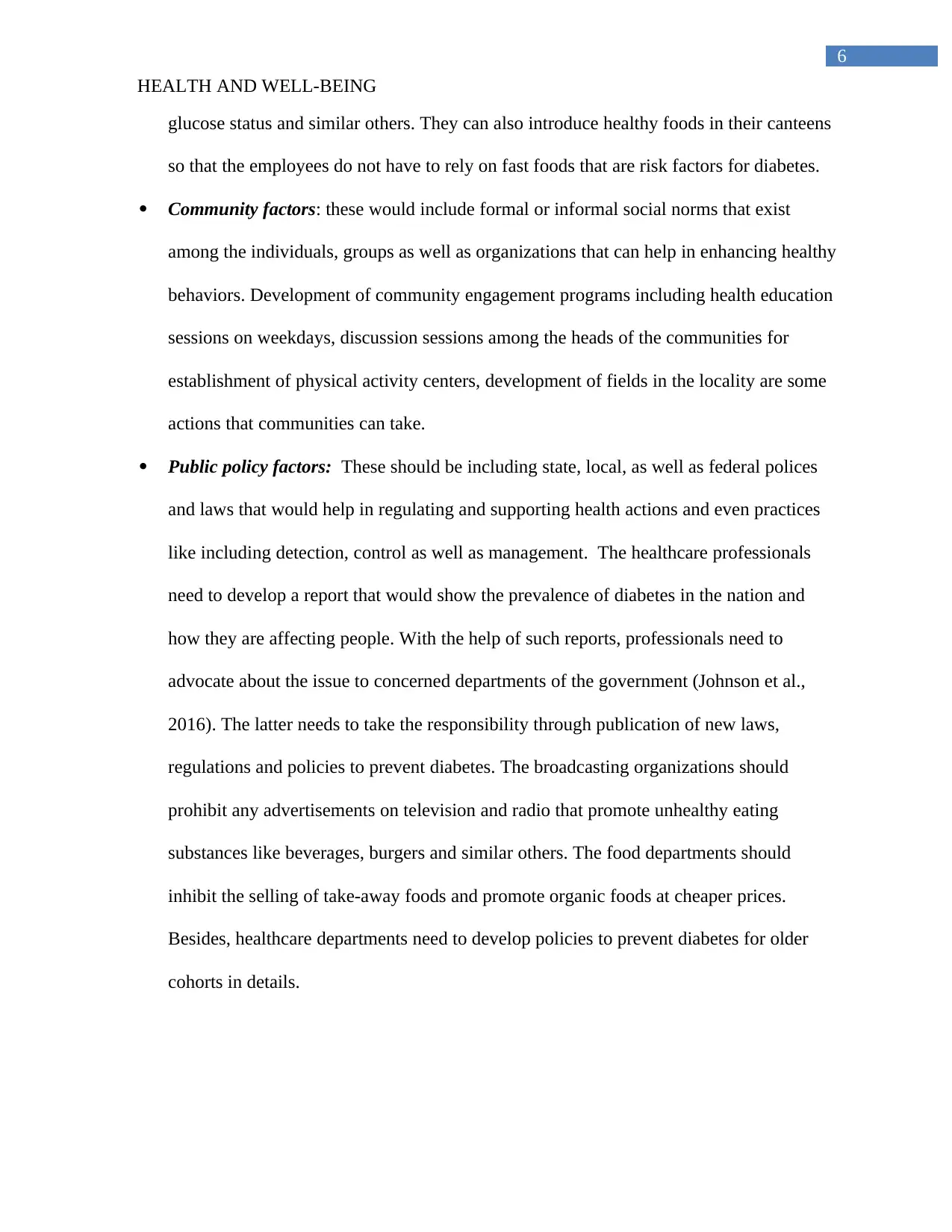
6
HEALTH AND WELL-BEING
glucose status and similar others. They can also introduce healthy foods in their canteens
so that the employees do not have to rely on fast foods that are risk factors for diabetes.
Community factors: these would include formal or informal social norms that exist
among the individuals, groups as well as organizations that can help in enhancing healthy
behaviors. Development of community engagement programs including health education
sessions on weekdays, discussion sessions among the heads of the communities for
establishment of physical activity centers, development of fields in the locality are some
actions that communities can take.
Public policy factors: These should be including state, local, as well as federal polices
and laws that would help in regulating and supporting health actions and even practices
like including detection, control as well as management. The healthcare professionals
need to develop a report that would show the prevalence of diabetes in the nation and
how they are affecting people. With the help of such reports, professionals need to
advocate about the issue to concerned departments of the government (Johnson et al.,
2016). The latter needs to take the responsibility through publication of new laws,
regulations and policies to prevent diabetes. The broadcasting organizations should
prohibit any advertisements on television and radio that promote unhealthy eating
substances like beverages, burgers and similar others. The food departments should
inhibit the selling of take-away foods and promote organic foods at cheaper prices.
Besides, healthcare departments need to develop policies to prevent diabetes for older
cohorts in details.
HEALTH AND WELL-BEING
glucose status and similar others. They can also introduce healthy foods in their canteens
so that the employees do not have to rely on fast foods that are risk factors for diabetes.
Community factors: these would include formal or informal social norms that exist
among the individuals, groups as well as organizations that can help in enhancing healthy
behaviors. Development of community engagement programs including health education
sessions on weekdays, discussion sessions among the heads of the communities for
establishment of physical activity centers, development of fields in the locality are some
actions that communities can take.
Public policy factors: These should be including state, local, as well as federal polices
and laws that would help in regulating and supporting health actions and even practices
like including detection, control as well as management. The healthcare professionals
need to develop a report that would show the prevalence of diabetes in the nation and
how they are affecting people. With the help of such reports, professionals need to
advocate about the issue to concerned departments of the government (Johnson et al.,
2016). The latter needs to take the responsibility through publication of new laws,
regulations and policies to prevent diabetes. The broadcasting organizations should
prohibit any advertisements on television and radio that promote unhealthy eating
substances like beverages, burgers and similar others. The food departments should
inhibit the selling of take-away foods and promote organic foods at cheaper prices.
Besides, healthcare departments need to develop policies to prevent diabetes for older
cohorts in details.
Paraphrase This Document
Need a fresh take? Get an instant paraphrase of this document with our AI Paraphraser
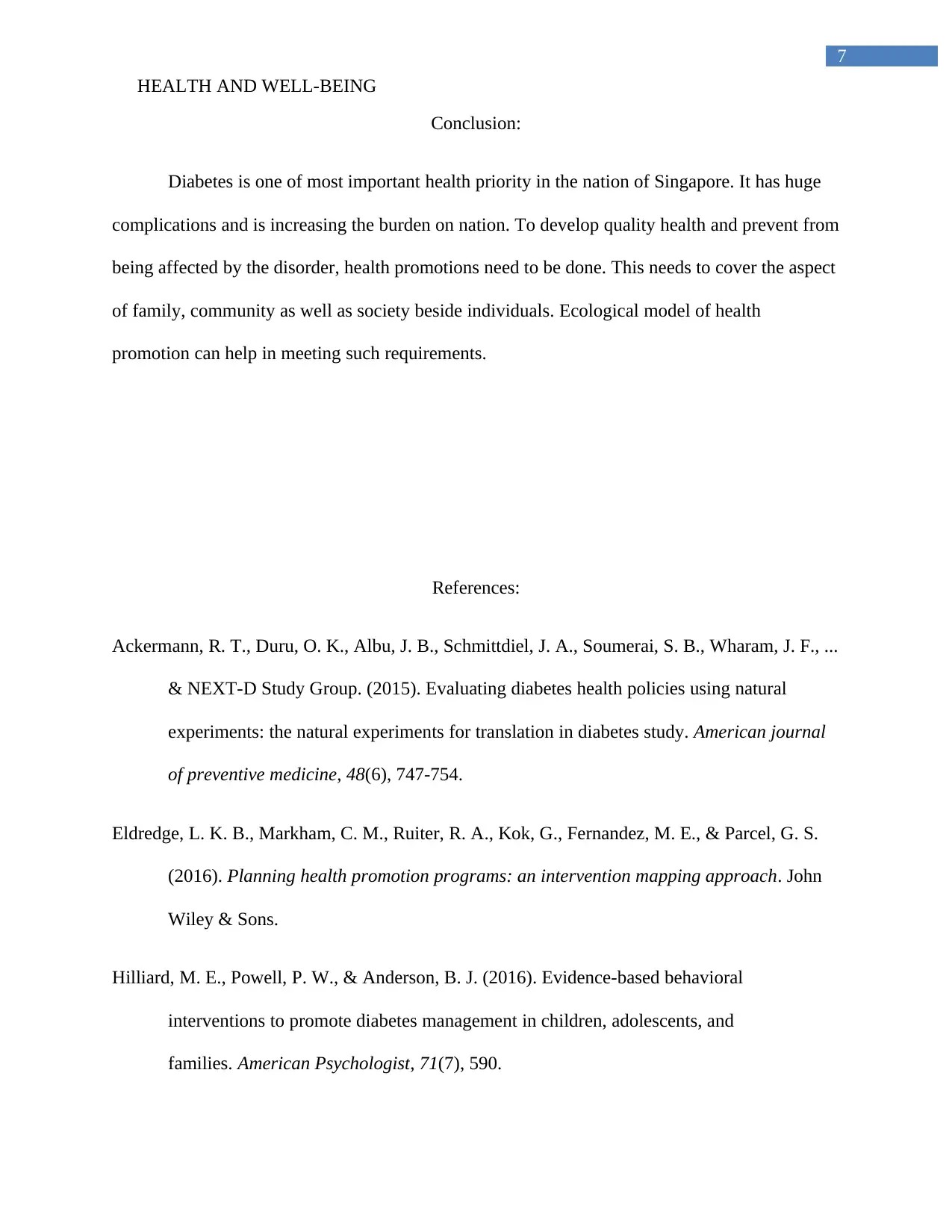
7
HEALTH AND WELL-BEING
Conclusion:
Diabetes is one of most important health priority in the nation of Singapore. It has huge
complications and is increasing the burden on nation. To develop quality health and prevent from
being affected by the disorder, health promotions need to be done. This needs to cover the aspect
of family, community as well as society beside individuals. Ecological model of health
promotion can help in meeting such requirements.
References:
Ackermann, R. T., Duru, O. K., Albu, J. B., Schmittdiel, J. A., Soumerai, S. B., Wharam, J. F., ...
& NEXT-D Study Group. (2015). Evaluating diabetes health policies using natural
experiments: the natural experiments for translation in diabetes study. American journal
of preventive medicine, 48(6), 747-754.
Eldredge, L. K. B., Markham, C. M., Ruiter, R. A., Kok, G., Fernandez, M. E., & Parcel, G. S.
(2016). Planning health promotion programs: an intervention mapping approach. John
Wiley & Sons.
Hilliard, M. E., Powell, P. W., & Anderson, B. J. (2016). Evidence-based behavioral
interventions to promote diabetes management in children, adolescents, and
families. American Psychologist, 71(7), 590.
HEALTH AND WELL-BEING
Conclusion:
Diabetes is one of most important health priority in the nation of Singapore. It has huge
complications and is increasing the burden on nation. To develop quality health and prevent from
being affected by the disorder, health promotions need to be done. This needs to cover the aspect
of family, community as well as society beside individuals. Ecological model of health
promotion can help in meeting such requirements.
References:
Ackermann, R. T., Duru, O. K., Albu, J. B., Schmittdiel, J. A., Soumerai, S. B., Wharam, J. F., ...
& NEXT-D Study Group. (2015). Evaluating diabetes health policies using natural
experiments: the natural experiments for translation in diabetes study. American journal
of preventive medicine, 48(6), 747-754.
Eldredge, L. K. B., Markham, C. M., Ruiter, R. A., Kok, G., Fernandez, M. E., & Parcel, G. S.
(2016). Planning health promotion programs: an intervention mapping approach. John
Wiley & Sons.
Hilliard, M. E., Powell, P. W., & Anderson, B. J. (2016). Evidence-based behavioral
interventions to promote diabetes management in children, adolescents, and
families. American Psychologist, 71(7), 590.
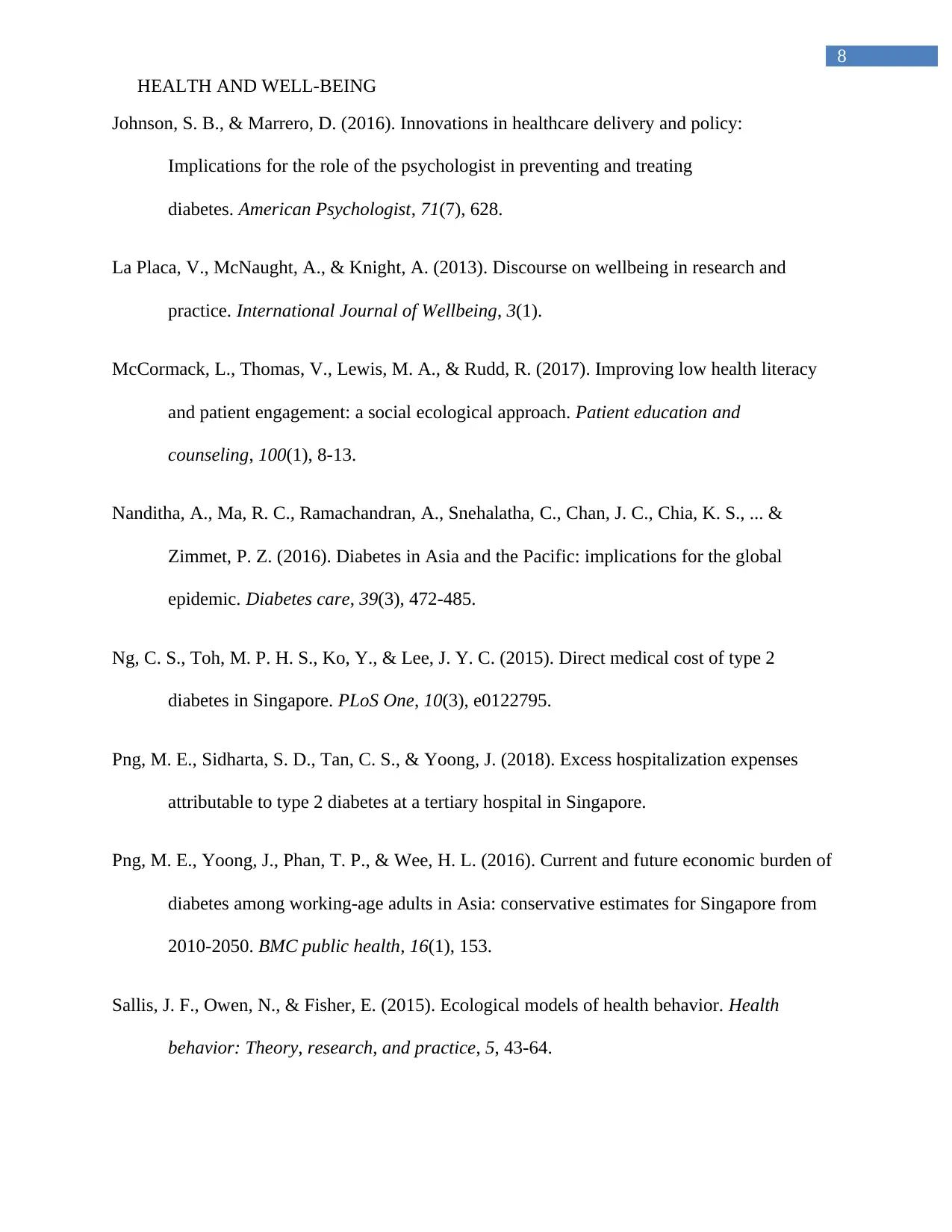
8
HEALTH AND WELL-BEING
Johnson, S. B., & Marrero, D. (2016). Innovations in healthcare delivery and policy:
Implications for the role of the psychologist in preventing and treating
diabetes. American Psychologist, 71(7), 628.
La Placa, V., McNaught, A., & Knight, A. (2013). Discourse on wellbeing in research and
practice. International Journal of Wellbeing, 3(1).
McCormack, L., Thomas, V., Lewis, M. A., & Rudd, R. (2017). Improving low health literacy
and patient engagement: a social ecological approach. Patient education and
counseling, 100(1), 8-13.
Nanditha, A., Ma, R. C., Ramachandran, A., Snehalatha, C., Chan, J. C., Chia, K. S., ... &
Zimmet, P. Z. (2016). Diabetes in Asia and the Pacific: implications for the global
epidemic. Diabetes care, 39(3), 472-485.
Ng, C. S., Toh, M. P. H. S., Ko, Y., & Lee, J. Y. C. (2015). Direct medical cost of type 2
diabetes in Singapore. PLoS One, 10(3), e0122795.
Png, M. E., Sidharta, S. D., Tan, C. S., & Yoong, J. (2018). Excess hospitalization expenses
attributable to type 2 diabetes at a tertiary hospital in Singapore.
Png, M. E., Yoong, J., Phan, T. P., & Wee, H. L. (2016). Current and future economic burden of
diabetes among working-age adults in Asia: conservative estimates for Singapore from
2010-2050. BMC public health, 16(1), 153.
Sallis, J. F., Owen, N., & Fisher, E. (2015). Ecological models of health behavior. Health
behavior: Theory, research, and practice, 5, 43-64.
HEALTH AND WELL-BEING
Johnson, S. B., & Marrero, D. (2016). Innovations in healthcare delivery and policy:
Implications for the role of the psychologist in preventing and treating
diabetes. American Psychologist, 71(7), 628.
La Placa, V., McNaught, A., & Knight, A. (2013). Discourse on wellbeing in research and
practice. International Journal of Wellbeing, 3(1).
McCormack, L., Thomas, V., Lewis, M. A., & Rudd, R. (2017). Improving low health literacy
and patient engagement: a social ecological approach. Patient education and
counseling, 100(1), 8-13.
Nanditha, A., Ma, R. C., Ramachandran, A., Snehalatha, C., Chan, J. C., Chia, K. S., ... &
Zimmet, P. Z. (2016). Diabetes in Asia and the Pacific: implications for the global
epidemic. Diabetes care, 39(3), 472-485.
Ng, C. S., Toh, M. P. H. S., Ko, Y., & Lee, J. Y. C. (2015). Direct medical cost of type 2
diabetes in Singapore. PLoS One, 10(3), e0122795.
Png, M. E., Sidharta, S. D., Tan, C. S., & Yoong, J. (2018). Excess hospitalization expenses
attributable to type 2 diabetes at a tertiary hospital in Singapore.
Png, M. E., Yoong, J., Phan, T. P., & Wee, H. L. (2016). Current and future economic burden of
diabetes among working-age adults in Asia: conservative estimates for Singapore from
2010-2050. BMC public health, 16(1), 153.
Sallis, J. F., Owen, N., & Fisher, E. (2015). Ecological models of health behavior. Health
behavior: Theory, research, and practice, 5, 43-64.
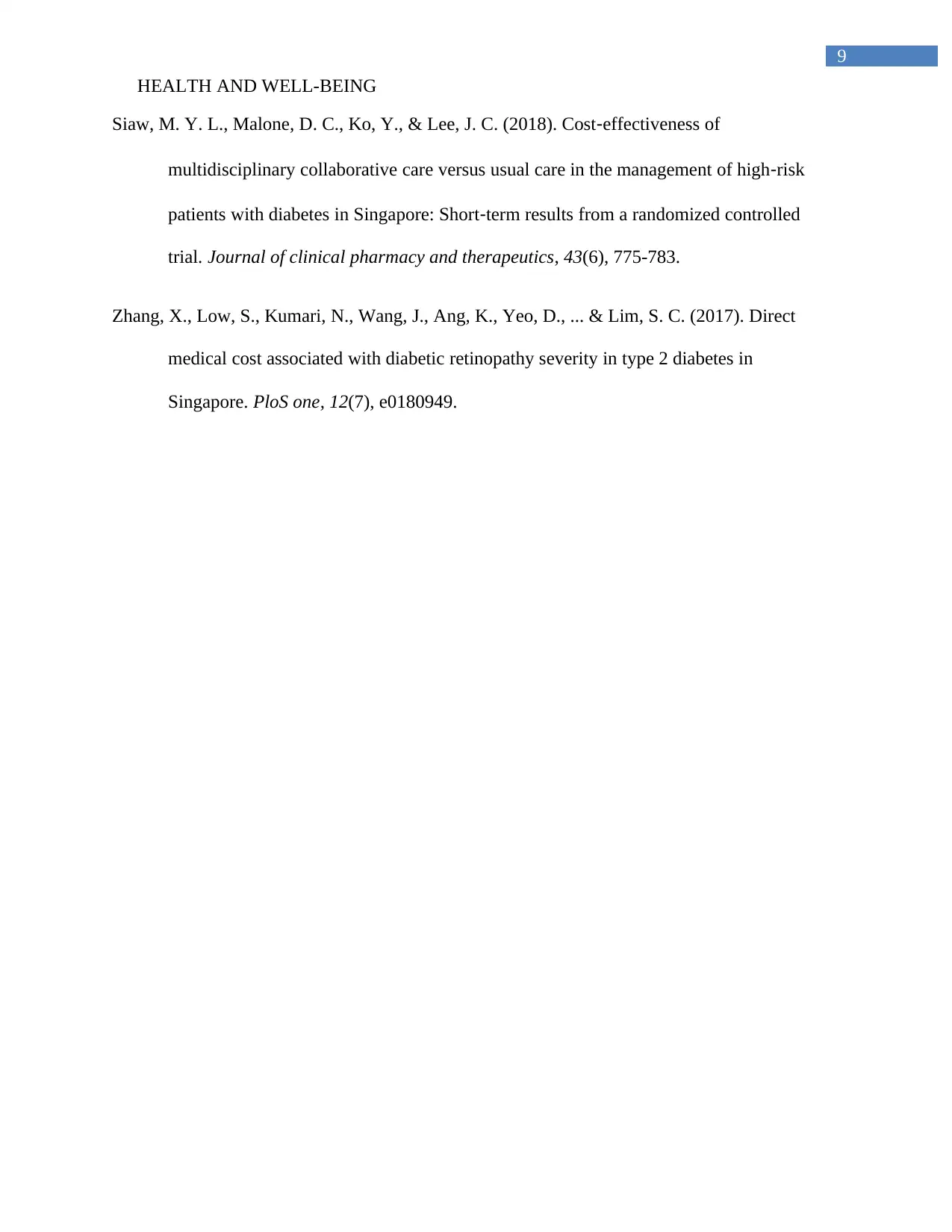
9
HEALTH AND WELL-BEING
Siaw, M. Y. L., Malone, D. C., Ko, Y., & Lee, J. C. (2018). Cost‐effectiveness of
multidisciplinary collaborative care versus usual care in the management of high‐risk
patients with diabetes in Singapore: Short‐term results from a randomized controlled
trial. Journal of clinical pharmacy and therapeutics, 43(6), 775-783.
Zhang, X., Low, S., Kumari, N., Wang, J., Ang, K., Yeo, D., ... & Lim, S. C. (2017). Direct
medical cost associated with diabetic retinopathy severity in type 2 diabetes in
Singapore. PloS one, 12(7), e0180949.
HEALTH AND WELL-BEING
Siaw, M. Y. L., Malone, D. C., Ko, Y., & Lee, J. C. (2018). Cost‐effectiveness of
multidisciplinary collaborative care versus usual care in the management of high‐risk
patients with diabetes in Singapore: Short‐term results from a randomized controlled
trial. Journal of clinical pharmacy and therapeutics, 43(6), 775-783.
Zhang, X., Low, S., Kumari, N., Wang, J., Ang, K., Yeo, D., ... & Lim, S. C. (2017). Direct
medical cost associated with diabetic retinopathy severity in type 2 diabetes in
Singapore. PloS one, 12(7), e0180949.
1 out of 10
Related Documents
Your All-in-One AI-Powered Toolkit for Academic Success.
+13062052269
info@desklib.com
Available 24*7 on WhatsApp / Email
![[object Object]](/_next/static/media/star-bottom.7253800d.svg)
Unlock your academic potential
© 2024 | Zucol Services PVT LTD | All rights reserved.




